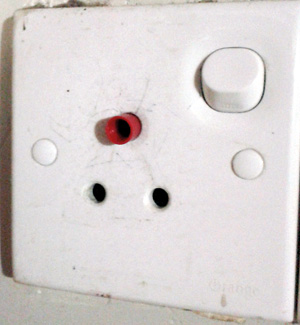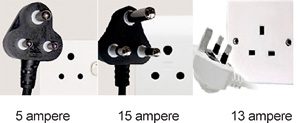Sunday Times 2
At last, Sri Lanka moves to a single standard plug socket
Electricity is now an essential commodity. The electrification level in Sri Lanka is about 95% and will increase with ongoing development in the North and East. Electricity has made our lives more comfortable. On the other hand, there are a considerable number of accidents every year.

To reduce accidents caused by unsafe plugs, the Public Utilities Commission of Sri Lanka (PUCSL) has decided to standardize plugs and socket outlets.
Negligence, unsafe electrical wiring and equipment are the main reasons for this increase. To reduce these accidents, the first step is proper electrical installation in our premises. Although rules and regulations in this regard have been issued in the past, and more recently under the 2009 Electricity Act, only a few adhere to them. Electricians and users alike largely ignore these regulations.
To reduce accidents caused by unsafe plugs, the Public Utilities Commission of Sri Lanka (PUCSL) has decided to standardize plugs and socket outlets. The announcement is published on its website since October 2, 2015.
At present, we use different types of plugs and socket outlets. The Sri Lanka Standards Institution (SLSI) has standardised only three of them: the five ampere (round pin), 15 ampere and 13 ampere (both square pin) plugs and socket outlets. However, as there are no regulations to prohibit the import or sale of other types of plugs and socket outlets, a large number of different types of plugs and socket outlets are available.
The PUCSL suggests that the 13A plug and socket outlets should be the single standard for non-industrial use in the country. This is because it is the safer and in use worldwide. Other reasons for this selection are included in a consultation paper published by the PUCSL which can be downloaded from its website.
We engineers agree that the 13A square pin socket and plug are safer. As the 13A socket has rectangular holes, it does not allow anything to be inserted to it other than its plug. At the same time, because of the flat to flat contact between the plug and the socket, a proper electrical connection is made without heating.
The 13A socket has a shutter mechanism which opens only when the earth pin is inserted into it. This means the risk of electric shock is very low. There is a fuse inside the 13A plug which offers added safety. As this 13A plug and socket outlet is already in use in Sri Lanka, the selection for the standardisation by PUCSL is certainly the best choice.
Stakeholders will have different views regarding the selection of this type of plug and socket. Whatever they are, it is important that we build a positive attitude towards this movement. Among the countries that have adopted the 13A plug and socket are Britain, Saudi Arabia, Singapore, Scotland, Ireland and Malaysia as their single standard. The electrical equipments they import also carry the standard 13A plug. The law prohibits the sale of other types.
According to the consultation paper, the standardization process will take some time. New rules and regulations will have to be implemented to legally prohibit the import and manufacture of other types of plugs and sockets. Socket outlets currently installed in premises need not be replaced. From May 2016, however, new buildings must be wired only with standard 13A socket outlets following wiring regulations under the 2009 Electricity Act.
At the same time, PUCSL will take necessary steps to recommend a standardised adaptor to convert the 5A plugs of the equipment you now use to the new 13A standard socket outlet. Another standardised adaptor would be required to convert the 13A plug of new equipment to the conventional 5A socket outlets many of us already have at home. It is important that the country adopts rules and regulations for electricians.
All plugs, socket outlets, and plugs connected to electrical equipment either imported into or manufactured in the country will have to follow the new standard. From May 2017, the sale of unsafe multi plugs and extension cords will be prohibited and all equipments on sale will have the standard 13A plug.
Today, as plugs most often do not match the sockets, we face difficulties all the time. When we buy a new appliance, we pay scant regard to the plug that comes with it. Even if we do care, the shopkeeper has no alternative plug (that matches the socket at home) to offer. After we take it home, we search around to find a proper socket outlet to connect the equipment.
If there isn’t a matching one, we try a multi plug or an extension cord to connect the equipment. In this manner, we create demand for unsafe multi plugs and extension cords that can accommodate any plug. The need arises from the sale of equipment in the market with various plugs.

Three types of plugs and sockets already in use
Currently, 5A, better known as the round pin socket outlet, is widely used in house wiring. Only in special instances, such as the wiring of an air conditioner circuit, are 15A socket outlets used. The 13A (square pin) version, too, has been available for some time. There are several drawbacks in the 5A and 15A plugs and socket outlets.
A child can easily insert a finger into the round holes and be exposed to electric shock. Similarly, if the plug is not properly inserted into the socket hole, only point contacts will be made. Those point contacts will heat up excessively and pose a fire risk. Most of the plugs in Sri Lankan markets today (two-pin plug, two-pin plug with earth hole etc) can be used with the 5A socket.
Using plugs other than the 5A plug on the 5A socket is unsafe. It has become a habit to use a pen to connect a two-pin plug onto the 5A round pin socket. Furthermore, most electric kettles, electric irons, etc, do not have the earth pin. Using this electrical equipment without a proper earth connection is dangerous.
Should there be a fault the trip switch in the house will only operate if the earth pin is connected to the socket. If there is no trip switch or if it is faulty, what happens to the poor soul touching the faulty iron?
Although not officially reported, many accidents occur due to unsafe multi plugs and extension cords as they are not made to standard. There should be a properly rated fuse in multi plugs as well as in extension cords and they should be well insulated. What we observe are many de-rated multi plugs and extension cords, using flimsy wires, with no safety features at all.
Count the number of appliances around your house connected in any of the following methods: multi-socket, extension cord or two-pin plug on a three-pin socket. Nine out of ten appliances will be connected in an unsafe manner.
We must systematically move to a single standard for plugs and socket outlets. Then nine out 10 appliances in homes will be properly and safely connected. Finally, when the transition is complete, ten out of ten will be safely connected.
(The writer is an Electrical Engineer)

